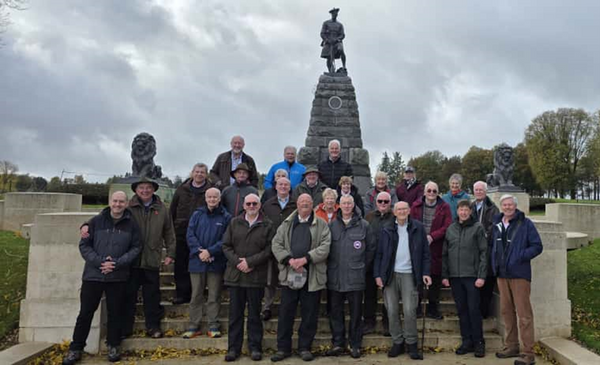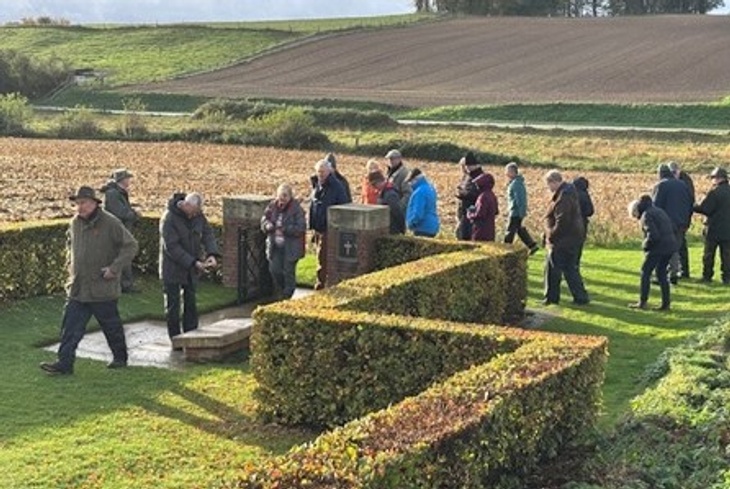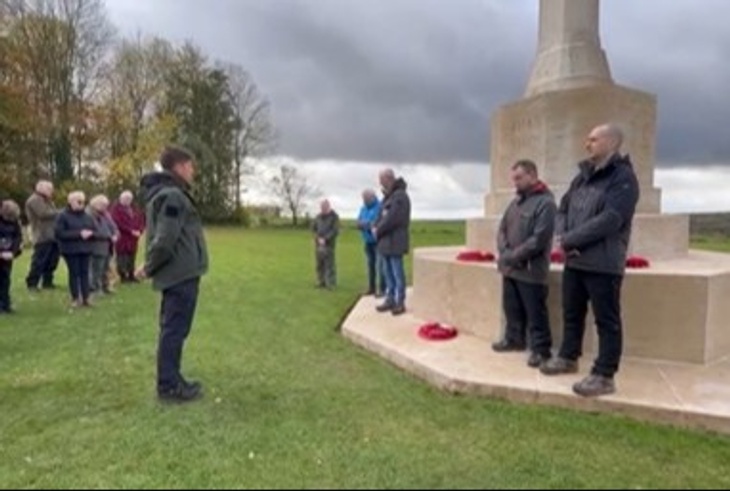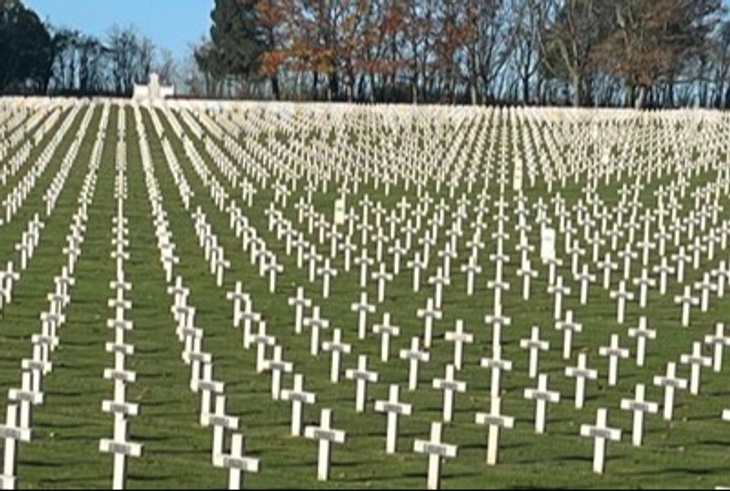“They shall not grow old, as we that are left grow old. Age shall not weary them, nor the years condemn. At the going down of the sun and in the morning…we will remember them.”

This was our second battlefield tour following our successful trip to Ypres in 2024. This time, 23 Liveryman, partners and guest made the journey, again hosted by Mark Smith of Antiques Roadshow fame as well as Peter Whapshott his friend and business partner in Barbed Wire Tours.
We gathered for a 0700 departure from Ebbsfleet International station before making our way down to Dover to catch the ferry to Calais at 1055. Despite a small hiccup with the new immigration process at the port, we reached the Somme battlefield mid-afternoon where Peter Whapshott introduced the tour and the key points and locations of the ground we were visiting.
We started at the northern end of the Somme frontline, visiting the site of the attack of the ‘Pals’ battalions around Serre, the day one objective. The ‘Pals’ consisted of battalions formed within a particular town and Sheffield, Barnsley, Accrington amongst many others are represented here. Despite incredible valour these attacks were a complete disaster as witnessed by the numerous memorials and cemeteries in the vicinity. We also visited the grave of Corporal Yandell who was killed on 17th July and is a relative of Liveryman Graham, his brother Brian and Liveryman Rob Yandell who laid a wreath in his memory.
As the rain was falling and daylight failing, we checked into our hotel at Albert before heading out for a convivial group dinner at Avril Williams’ guest house at nearby Auchonvillers which also has a fascinating museum, original trenches and a dressing station.
Day two took us to the site of the Hawthorne Ridge crater, a massive mine exploded by the British under the German front line on 1st July 1916 and captured by Geoffrey Mallins in his famous film of the battle in 1916. Nearby is the sunken lane also made famous in Mallin’s film, and we walked across no-mans land and into the crater as we heard of yet another disastrous British attack from 1st July.
Next was the Newfoundland Park, so named because of the sacrifice of the regiment of the same name on 1st July. The site is well preserved so the British and German positions are clear to see, and Mark led us around the site of fighting that finally concluded in November 1916 when the German positions were finally overcome by 51st Highland Division. There are several cemeteries and memorials around this place and the park itself is a fitting tribute to the brave lads of 1916.
A short drive south took us to the impressive Thiepval Memorial to the Missing which records the names of more than 70,000 British and Commonwealth soldiers lost at the Somme with no known resting place. We had an emotional service led by members of our group and a wreath was laid on behalf of WCB at the Cross of Sacrifice. On the way we passed the Ulster Tower, dedicated in 1921 to the lads of the 36th Ulster Division who attacked, initially with some success, at this place on 1st July.
Our tour now crossed the midpoint of the Somme battlefield at La Boisselle, and our next stop was the nearby Lochnagar Crater, where the British exploded 27 tons of high explosive under the German positions leading to a crater 67m deep and 140m across. Unfortunately, the Germans recovered themselves either side of the crater and the British attack failed to break through, again with heavy casualties.
After a very much appreciated pack lunch provided by Avril Williams, we travelled across the southern end of the battlefield where there was a fair amount of success in terms of ground taken, despite there being many heavily defended woods to overcome. We stopped at the German cemetery at Fricourt and remembered that they too were sons, brothers, uncles and fathers despite the different uniform, and who suffered as much as our lads through this battle. We passed through the villages of Montauban, Guillemont, Longueval and Pozieres before another stop, this time at the tank memorial near Courcelette, the location of the first use of tanks in September 1916 when they supported attacks between the villages of Flers and Courcelette and caused terror to the German defenders. All the while, Peter and Mark told some wonderful stories, bringing to life the Somme battle which ran from July till November 1916. In particular at this point, the contribution of the Australians and Canadians who fought with great bravery and some success around Pozieres and Courcelette.
Our final stop of the day was at the pretty cemetery of Bazentin Le Petit, where, in a lovely sunny autumn moment, we remembered Harry Hands, a Northants lad and a relative of Angela Evans, one of our party.
After a long day, it was back to the hotel before another most pleasant evening at Avril Williams.
Our final day heading back to Calais saw us stop near Arras at Notre Dame de Lorrette, the France National Memorial where in the vicinity there are hundreds of thousand headstones in British, French and German cemeteries, several of which we paused to visit. At the Memorial itself there is an astonishing memorial wall 1km in length which records the name of every soldier killed in the Artois region situated between the Somme and the Belgium frontier. A total of 580,000 names of all nationalities was truly a mind-boggling sight.
After a coffee and a walk around the National Memorial it was back on the coach to catch the afternoon ferry home from Calais.
I would like to thank Barbed Wire Tours for a most amazing weekend in Ypres. Mark and Peter were superb hosts and tour guides, bringing the battle and the context of WW1 to life for the group who really appreciated their knowledge and humour. Thank you also to the intrepid travellers who joined the tour and help make the weekend fun and a most interesting couple of days. We will go again next year.
by Assistant Mike Attwood


